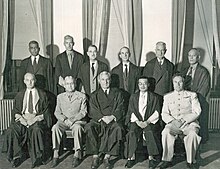User:Hawkeye7/Book Reviews
Wikipedia talk:WikiProject Military history/Coordinators/Newsroom
Gary J. Bass - Judgment at Tokyo |
![]()
![]()
![]()
![]()
![]()
- By Hawkeye7

While the Nuremberg trials are quite well known, the story of the Tokyo trials is much less so. They differed from those in Germany in several ways. Perhaps the most obvious was the makeup of the court. While sometimes depicted as an American affair, the prospect of American domination of the trials was destroyed by the rampant cronyism that was a hallmark of the Truman administration. The American chief prosecutor President Harry S. Truman appointed, Joseph B. Keenan, was usually ill-prepared, invariably inept, and often intoxicated. While Nuremberg had four judges from the United States, France, United Kingdom and the Soviet Union, the Tokyo trials had eleven, with judges from Australia, Canada, China, India, the Netherlands, New Zealand and the Philippines as well. Australia's Sir William Webb presided as chief judge, and the justices from Canada, New Zealand and the United Kingdom formed an important voting bloc.
As at Nuremberg,The defendants were arraigned on four charges: crimes against peace, war crimes, crimes against humanity and criminal conspiracy. The crime of conspiracy (to commit one or more of the other three) was an Anglo-American legal concept, and not part of that of Japan or most of the nations represented on the court. In the 1940s, crimes against peace were considered the worst type, and those arraigned on it were considered Category A; those accused merely of war crimes were Category B and faced military courts. At Tokyo, Unlike Nuremberg, only Category A were tried, so all the defendants were high-ranking government or military officials.
The prosecution, defence and the accused were all eager to let the emperor Hirohito off the hook. This meant that the Nuremberg defence was fraught with peril, as pointing the finger at your superior would inevitably have led to it being pointed at the emperor. This happened anyway, through numerous gaffes by all three parties which incriminated Hirohito. The insistence that no one would oppose the emperor raised the question why he did not prevent the war if he was opposed to it (and why he could not have ended it before August 1945); if he could commute the sentences of five of the Doolittle raid airmen, why not the other three? Webb was completely convinced that the emperor was guilty and said so (but in Australia the prosecution can decline to prosecute for any reason or no reason at all).
The court was divided over the thorny issue of the legitimacy of the trial. Were crimes against peace really established crimes under international law? The 1928 Kellogg–Briand Pact outlawed war as an instrument of policy, but said nothing about personal responsibility. The court could have fallen back on its own mandate, but this would have affirmed that it was victors' justice and would not have set any precedent. Webb attempted to justify this on the grounds of natural law, but this did not satisfy the other British Commonwealth justices. Nor were they impressed with Soviet judge Ivan Zaryanov's submission, which argued that it was permissible for democracies to invade autocratic fascist states.
Part of the problem was that the Allies did not have clean hands: the Soviet Union had invaded Finland in 1939 (which got it kicked out of the League of Nations); Britain had invaded Iran; the United States had occupied Greenland; and Australia and the Netherlands had occupied East Timor. (The defence also raised the matter of the unprovoked Soviet attack on Japan in August 1945, at the instigation of the United States and United Kingdom.) India's Radhabinod Pal and the Netherlands' Bert Röling were not convinced. Pal eventually rejected the evidence presented of Japanese atrocities in China, Indonesia and the Philippines, and became a Holocaust denier.
There was also the matter that Japan had surrendered on the basis of the Potsdam Declaration, which only specified war crimes and not the newly-created (and retrospective) crimes against peace or crimes against humanity. A unanimous verdict became impossible, with the court was riven by internal conflicts. The author of the book, a professor of politics and international relations in the Princeton School of Public and International Affairs at Princeton University, repeatedly claims that aerial bombardment was a war crime, only to have to back away from his own words and admit that it was not the case.
Publishing details: Bass, Gary J. (2023). Judgment at Tokyo: World War II on Trial and the Making of Modern Asia. New York: Alfred A. Knopf. ISBN 978-1-101-94710-4. OCLC 1360277874.
